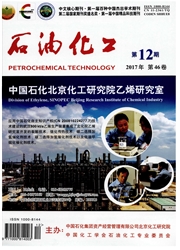

 中文摘要:
中文摘要:
针对硝基苯加氧合成对氨基苯酚(PAP)反应,于反相微乳液体系中,采用重新分散沉积负载法和改进的微乳-溶胶凝胶负载法制备了不同Pt粒径的Pt/SiO2倦化剂,考察了Pt粒径对反应活性及选择性的影响。实验结果表明,采用改进的微乳-溶胶凝胶负载法制备的Pt/SiO2催化剂,Pt粒子在载体表面分散得更均匀,且粒径较小。在Pt/SiO2催化剂制备过程中加入一定量的草酸及改变H2PtCl6溶液浓度,均对Pt粒径有一定的调控作用。以制备的不同Pt粒径的Pt/SiO2为加氖反应催化剂、以S2O8^2-/ZrO2固体酸为重排反应催化剂进行硝基苯加氢合成PAP反应。实验结果表明,随Pt粒径的减小,硝基苯转化率及PAP的选择性均明显提高,当Pt粒径为5.1nm时,PAP的选择性最高,为48.5%。
 英文摘要:
英文摘要:
Pt/SiO2 catalysts with different Pt particle sizes were prepared separately by reverse microemulsion using redispersion deposition method and improved microemulsion sol-gel process. The obtained catalysts together with a S2O8^-/ZrO2 solid acid rearrangement catalyst were used in hydrogenation of nitrobenzene(NB) to synthesize p-aminophenol(PAP). The effect of Pt particle size on catalytic performance of Pt/SiO2 was investigated. The Pt particle sizes on the catalyst prepared by improved microemulsion sol-gel process were small and well dispersed. The Pt particle size could be controlled by adding a certain amount of oxalic acid in solution of H2PtCl6 or changing concentration of the latter. Using mixture of Pt/SiO2 and S2O8^2--/ZrO2 solid acid as catalyst the hydrogenation of NB to synthesize PAP was carried out. When Pt particle size decreased the NB conversion and PAP selectivity increased obviously. When Pt particle size was 5. 1 nm, the conversion of NB was almost complete and selectivity to PAP was 48.5 %.
 同期刊论文项目
同期刊论文项目
 同项目期刊论文
同项目期刊论文
 期刊信息
期刊信息
